23+ Latest Content Marketing Statistics For 2024
What is the state of content marketing?
It’s safe to say that content marketing is here to stay but it is in a constant state of flux.
Content types, distribution platforms, content consumption, and more. It’s all changing.
To help you keep your finger on the pulse of what’s working in the content marketing space, we’ve put together this collection of the content marketing statistics that you need to know.
Editor’s picks
- 35% of organizations don’t have dedicated content marketing teams. (Content Marketing Institute)
- 79% of companies use content marketing to generate quality leads. (Semrush)
- There are currently more than 600 million blogs as of 2021. (Hosting Tribunal)
Content marketing adoption statistics and trends
How have consumers and businesses embraced content marketing? In this section, we’ll give you the general content marketing statistics that’ll give you a better idea of the current status of the industry.
You’ll find out just how many marketers are using content marketing to its fullest potential as well as what goals they’re trying to achieve by doing so.
35% of organizations don’t have dedicated content marketing teams.
Surprisingly, only 35% of organizations have a dedicated person or team that works on content marketing full time. This is especially true for smaller companies that have 1 to 99 employees. 50% of small companies have no dedicated content marketing personnel.
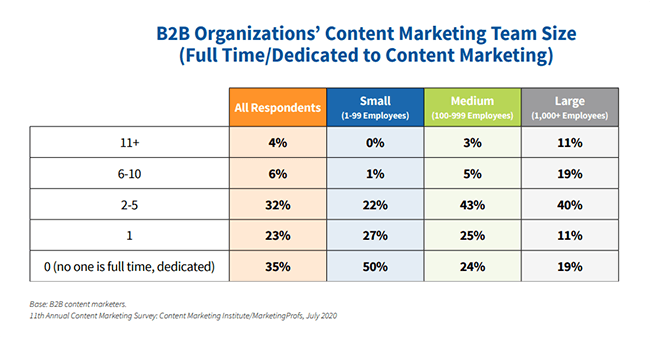
The larger an organization grows, the more people they dedicate to content marketing. For large organizations (1,000+ employees), 40% of them would have two to five people working on their content.
Source: Content Marketing Institute
84% of organizations have a content marketing strategy.
SEMrush asked 1,500+ marketing agencies and businesses if they have a content marketing strategy. 84% said that they do. However, only 11% said that they consider their strategy to be an excellent one.

The survey also had other interesting tidbits. For instance, 49% of those surveyed reported social media as the hardest skill to master. This is followed by SEO at 44% then by strategy at 42%.
Source: SEMrush
Related Reading: 12 Best Content Writing Tools For SEO.
3 out of 4 B2C marketers believe their content marketing is successful.
In a survey, 3 out of 4 B2C marketers believed that their organizations have been moderately, very, or extremely successful with their content marketing efforts.
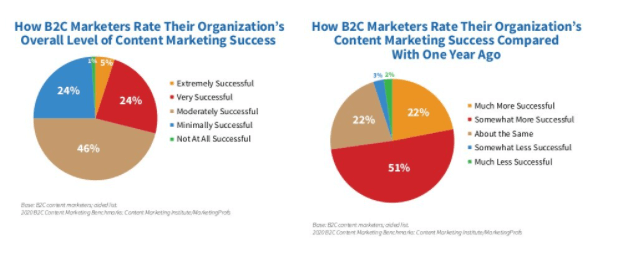
Breaking down the numbers, 5% said that their organizations were extremely successful. 24% believed they were very successful while 46% reported being moderately successful.
24% said they were minimally successful. 1% are of the opinion that they weren’t successful at all.
Source: 2020 B2C Content Marketing Benchmarks, Budgets & Trends
79% of companies use content marketing to generate quality leads.
An overwhelming number of companies said that their primary goal in 2020 with investing in content marketing is to generate more quality leads for their businesses.
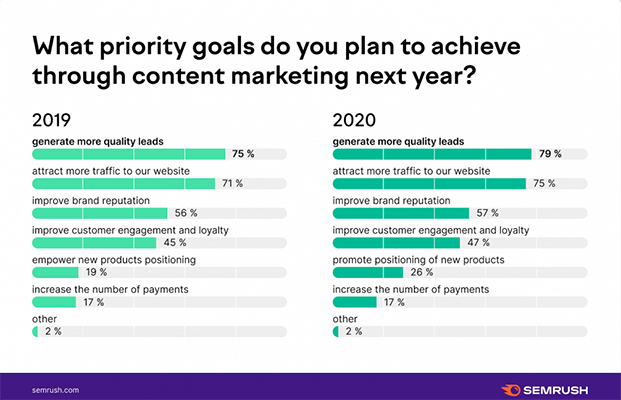
It doesn’t appear to be a changing goal either as this is also the goal that topped in 2019 at 75%.
Attracting more traffic to their websites only comes second at 75%. Other goals for 2020 included improving brand reputation (57%), improving customer engagement and loyalty (47%), promoting the positioning of new products (26%), increasing the number of payments (17%), and others (2%).
Source: SEMrush
Advisors predicted content marketing to be worth $412 billion by 2021.
Analysts from Technavio said that the content marketing industry will be worth $412.88 billion by 2021.
One of the reasons behind this optimistic prediction was that businesses have started to figure out what worked and what didn’t. Also, they’re now starting to understand how they should track and measure their return on investment.
Content marketing is also starting to align with how modern consumers shop including the use of the internet to access product information for research.
Source: MTA
Content marketing is expected to grow in 2021 to 2025.
According to the Content Marketing Market Forecast and Analysis Report 2021-2025 by Technavio, the market is expected to have a year-over-year growth rate of 15.73% in 2021 and is expected to grow further in the next couple of years.

APAC is the biggest market for content marketing. This is being attributed to the growing demand for digital magazines and the rise of social media users in the region.
Source: Technavio via PR Newswire
Consumers are looking for interactive content.
In an interview with BizReport, Impact.com VP of Marketing Cristy Garcia said that consumers are looking for content that they can connect, engage, and benefit from. She observed that people find targeted ads creepy and that they don’t resonate with them at all.
Instead, businesses should present users with interactive content such as unboxing videos, product reviews, advice, and recommendations. That’s how people are going to connect with a product organically.
She also said that authentic content is what drives a consumer to come back for more which develops brand loyalty.
Source: BizReport
People are suffering from digital fatigue.
During the 2021 Content Marketing World conference, Sitecore Product Marketing Director (Experience Platform) Jill Grozalksy Roberson stated that 59% of consumers feel like companies have lost touch with the human element of customer experience.
She then went on to say that 47% of people are seeking downtime from the internet due to digital fatigue.
To counteract that, businesses need to create positive, emotional brand associations. This will result in more loyal and trusting customers. To do this, you must remember to listen to your customers, watch your tone, use the right platforms to reach your audience, and personalize the experience.
Source: Skyword
Marketers cite a desire for perfection as the top obstacle to content production.
50% of marketers said that a desire for perfection is one of the biggest hurdles to their content production. Marketing teams spend 30% of their budgets on content creation. However, less than 40% of those marketers document their marketing strategy.
Source: Gartner
B2B content marketing statistics and trends
Business-to-business transactions are just as important as direct-to-consumer. So how are companies targeting other enterprises? And if you’re on the same boat, what content strategy should you be using to promote your content?
These are just some of the questions we intend to answer through the following content marketing statistics and trends.
79% of B2B marketers have content marketing strategies in place.
In a survey, 79% of B2B marketers stated that their organizations have a content marketing strategy. And of those organizations, 70% reported making moderate to major changes in their strategy due to the pandemic.

Interestingly, a significant part of these organizations—about 36%—do not document their content marketing efforts. Only 43% said that they do keep track of their content marketing strategy.
Source: Content Marketing Institute
78% of B2B consumers prioritize the content source’s trustworthiness.
78% of B2B consumers are critical of the source of their content. It’s important to them that they trust the site they’re getting their information from. On the other hand, 65% prefer that their content come from industry influencers.
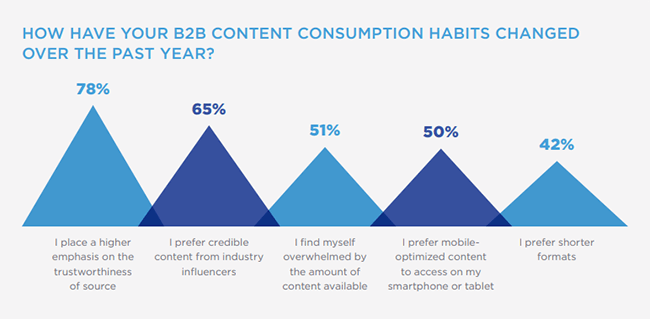
51% of respondents said that they find themselves overwhelmed by the amount of content available online. For 50% of users, they prefer their content to be mobile-optimized so that they can access information through a smartphone or a tablet.
42% said that they want their content shorter and easier to digest.
Source: 2018 Content Preferences Survey Report
Promote your B2B content on LinkedIn.
There are 58 million companies on LinkedIn. So if you’re a B2B company, it only makes sense to promote your content on the platform. This is the ideal place to market yourself since the whole point of this social media platform is to connect business owners with potential customers and partners.
But before you do, you should be aware of some best practices. For example, you shouldn’t hard-sell your products and services.
Source: Forbes
Blog content marketing statistics and trends
Blogs have always been a great way to generate new content and improve a site’s SEO. And to this day, people still use blog posts to promote products and services. Even through the pandemic, people are still posting new blog posts — even more so than they used to before Covid-19 happened.
Here are some blog content creation statistics that you need to know if you want to make changes to your content marketing efforts.
71% of users said they viewed a blog post during their buying journey.
You shouldn’t downplay the effects that blog post have on sales. According to the 2018 Content Preferences Survey Report, 71% of survey respondents said that they check a blog as they went through their buying journey.
But the report doesn’t stop there. People also listened to podcasts (64%), looked at infographics (76%), read case studies (79%), attended webinars (66%), and watched videos (49%).
Source: 2018 Content Preferences Survey Report
There are currently more than 600 million blogs as of 2021.
Out of the 1.9 billion websites out there in 2021, more than 600 million of them are blogs. And together, blog authors publish over 6 million blog posts per day. That’s 2.5 billion posts per year.
However, these numbers don’t take into account inactive websites. Also, not every blogging platform shares their data to the world. Still, this is nothing to scoff at. After all, a third of the world’s websites are blogs. Tumblr alone has 518 million blogs under its belt.
Source: Hosting Tribunal
Bloggers continued to post during the pandemic.
In a survey of 1,030 bloggers, 63.88% reported that they continued to post new content.
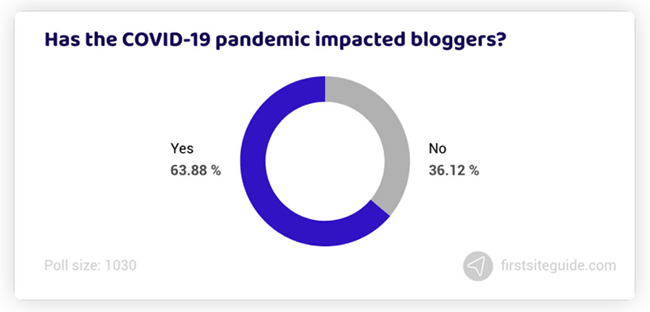
46.5% of respondents even said that they started blogging more during this time while only 27.18% said they started blogging less. The rest of the respondents said that the pandemic did not change their posting habits.
Those who posted more said they did so because they were stuck at home. Some bloggers posted less because they weren’t inspired to do so.
Source: First Site Guide
Readers prefer that blog posts be 1,000 words or fewer.
In a survey of 1,024 people in the United States, 75% of respondents said that they prefer blog posts or articles to come in under 1,000 words. Only 5% said that they want posts to be over 2,000 words.
This makes sense as most people don’t have the time to read long-form content. But not all posts can be as short as 500 words and under, especially when writing about a topic that needs a lot of explaining.
That is why you should consider publishing more articles that linger close to 1,000 words.
Source: Contently
Having quality blog content is the most important factor for generating credibility.
In a survey of bloggers, marketers, and business owners, 30% said that having quality content is the most important factor if you want to be viewed with credibility.
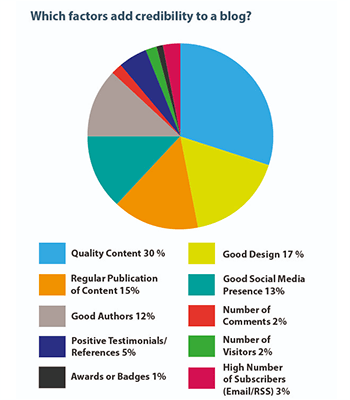
Some respondents take into account other factors. These include designing a good blog site (17%), posting consistently (15%), being active on social media (13%), having great authors (12%), and getting positive testimonials or comments (5%).
In addition, 62.96% of respondents said that having multiple authors on a site also generates credibility. Only 37.04% believe that being the sole author of a blog is better.
Scaling content output is difficult unless you have the right skills in-house. An alternative option would be to outsource this work to an article writing services or agency.
Source: Social Marketing Writing
Blog posts are more effective when promoted through social media.
Majority of bloggers today promote their posts through social media. And when users discover the blog, they’re more likely to take action. This includes downloading content or signing up for an opt-in offer.
66% of buyers said that blog posts were instrumental in their buying process.
Source: Business 2 Community
Video content marketing statistics and trends
Videos will play a major role in content marketing in the next couple of years. Visual content is important as proven by the following statistics and trends.
How can you leverage videos for your business? For content marketers, what should be your main priority? And what can you do to keep people engaged and inspire brand loyalty?
Let’s go over these video content marketing statistics.
Video ads are instrumental for brand discovery.
Animoto reports that video ads are the best way for consumers to discover a brand that they later buy products from. YouTube, in particular, is responsible for consumers checking out new products before purchasing.
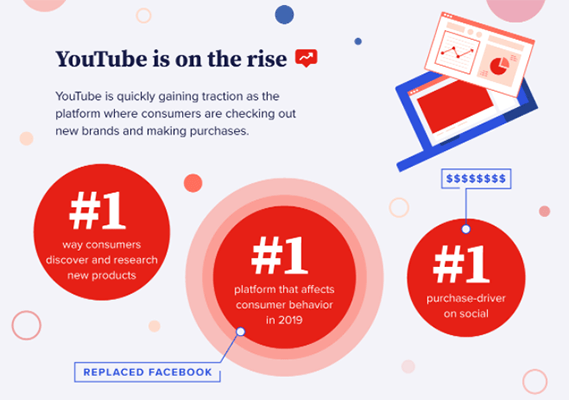
YouTube is topping other video platforms. Not only is it the best way for buyers to discover brands, but it’s also the top platform for affecting consumer behavior and purchase-driver on social media in 2019.
51% of users spend their time on YouTube. 45% are on Facebook while 39% are on Instagram.
Source: Animoto
Marketers who use video said it’s important to their marketing strategy.
93% of marketers who use videos said they’re very important to their marketing strategy in 2021. This is slightly up from 2020’s 92%.
86% of businesses said that they use video as a marketing tool. This is also up from the previous year wherein 85% said they use video.
What kind of videos do these companies produce?
The most common type of video they have are explainer videos (73%), social media videos (67%), presentation videos (51%), sales videos (41%), and video ads (41%).
Source: Wyzowl
86% of marketers said video content drives traffic to their sites.
86% of marketers said that thanks to video content, traffic to their sites have increased. Not only that, 83% added that videos helped increase the average time that users spend on their landing pages.
What’s even better is that 94% of marketers claimed that their videos helped customers and potential buyers understand what their product or service is all about. 84% went on to say that videos helped them generate new leads for their business.
And thanks to videos, 43% of video marketers experienced a reduction of calls for customer support.
Source: Wyzowl
78% of users got more site traffic after using videos.
According to a Renderforest survey, 78% of site owners experienced increased traffic to their website after adding videos. 71% also said that the average time that people spent on their pages increased after offering video content.
Furthermore, 69% of users generated more leads after the changes were made. And 54% said that their sales have also improved.
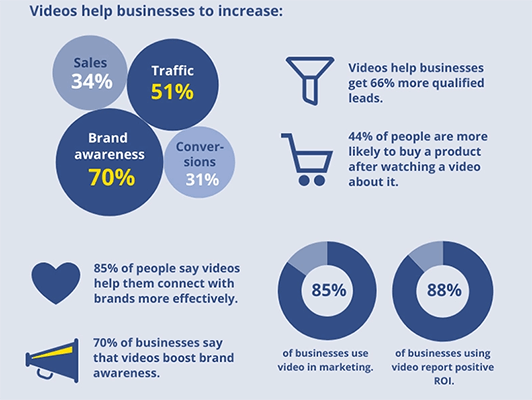
The most common video assets used were explainer videos (62%), logo animations (46%), presentations (43%), advertisements (38%), demos (33%), slideshows (30%), and others (17%).
Source: Renderforest
More people will watch videos if they are 1 minute long or under.
In Vidyard’s 2021 Video Benchmark Report, it says that over half of viewers will watch a video until the end if it’s under a minute long.
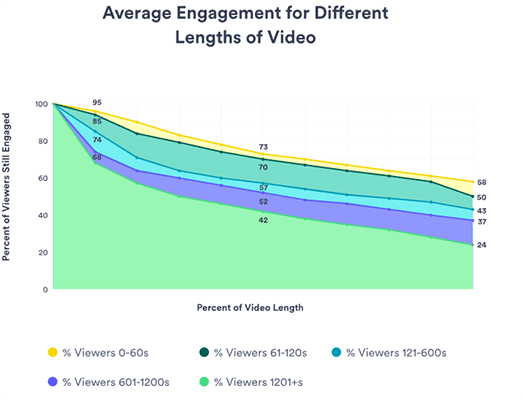
It should come as no surprise that the longer a video goes, the more significant the drop-off point will become.
The survey also points out that user-generated content makes up 60% of all videos created and posted online. There were more people uploading videos during the initial stages of the Covid-19 pandemic because a lot of organizations went digital.
As far as video production goes, larger companies are choosing to outsource these tasks while small- to medium-sized businesses are opting to use in-house resources for video creation.
Source: Vidyard
Content marketing statistics sources
Final thoughts
And that wraps up our roundup of the latest content marketing statistics.
With the majority of businesses placing such a strong focus on content marketing, it is clear that content marketing isn’t going anywhere.
From a career perspective, content marketers are in more demand than ever. Many businesses are hiring for niche roles within content marketing.
Larger businesses typically have their own content team and the majority of businesses at least have a content strategy in place.
But content marketing doesn’t make sense for every business. So, you’ll need to figure out whether or not your business can benefit from content marketing.
It’s also worth considering which marketing channels will be most important to you. For example, a content strategy will typically involve content being created for different channels such as email marketing, social media, and SEO. However, not all of these channels may make sense for your business.
The best starting point is to consider your business model and select marketing channels accordingly.
What’s next? We’ve compiled a quick list of other stats posts worth your time:
